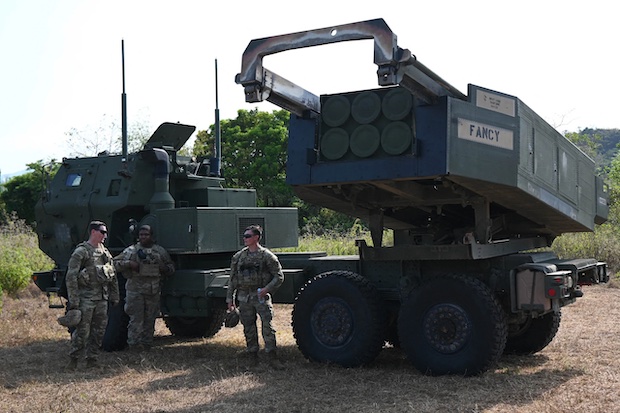‘Combat-ready’ force in biggest ‘Balikatan’

This photo taken on March 31, 2023, shows US Army soldiers standing next to their high mobility artillery rocket system (HIMARS) launcher prior to a live fire exercise during the joint exercise between the Philippines and the US at Fort Magsaysay in Nueva Ecija. (Photo by TED ALJIBE / Agence France-Presse)
MANILA, Philippines — The Philippines and the United States will stage their biggest-ever military exercise over the next several days starting Tuesday and signal tighter defense cooperation, amid China’s increasing assertiveness in the South China Sea and toward Taiwan.
Meanwhile, China is expected to conclude on Monday three days of military drills around self-ruled Taiwan, the island that Beijing views as its own territory.
The 18-day exercise between Manila and Washington dubbed “Balikatan,” a Tagalog term for “shoulder-to-shoulder” or “sharing the load together,” will involve more than 17,000 troops — 5,000 Filipinos, 12,000 Americans, and 111 Australians.
This participation is nearly double from last year’s 9,000 and also stands out from previous exercises in terms of size and scope.
Observers from other countries allied with the United States will also take part in this year’s Balikatan.
Some of the drills set to be carried out for the first time include live-fire training using Patriot missiles and Avengers air defense systems, both used by Ukraine to defend itself against Russia’s invasion.
The two allies will also sink a decommissioned 200-foot fishing vessel serving as a mock enemy ship, in waters facing the West Philippine Sea off Zambales province.
Balikatan spokesperson Col. Michael Logico said in a recent press conference that this year’s exercise would involve “venturing outside traditional training areas,” usually in landlocked venues, to further test interoperability and readiness in the drills.
“When we’re training with the Americans, it’s an opportunity for us to learn something new. We can always train by ourselves… but there’s a certain limit to what you can learn. Whenever you train with another country, the learning opportunity widens,” he pointed out.
Aside from live-fire training, the drills will cover maritime security, amphibious operations, urban and aviation operations, cyberdefense, counterterrorism, and humanitarian assistance and disaster relief preparedness.
‘Shared missions’
Logico said the recognition of the importance of the cyber domain was long overdue.
“A lot of our subsystems when it comes to command and control, [and] intelligence rely on the cyber domain. We will be creating scenarios involving a cyberattack and how to defend against it,” he said.
“Balikatan provides unparalleled opportunities to demonstrate the strength and readiness of the Philippine-US security alliance,” added Lt. Col. Daniel Huvane, Balikatan combined joint information director.
The Philippine Army, a ground-based force traditionally focused on fighting insurgency, recently wrapped up the first phase of the “Salaknib” exercise with its US counterpart, which focused on the “defense of the archipelago from potential foreign aggressors” by applying lessons learned from the Russia-Ukraine war.
Retired Armed Forces chief Emmanuel Bautista said the Balikatan and Salaknib drills have evolved in response to threats posed by an increasingly powerful China.
“We’re preparing because the threat has become more real now and you can no longer brush it aside. In a long time, we never saw a credible threat of invasion of the Philippine territory, but now it’s possible,” he told the Inquirer.
He said it was impossible for the Philippines not to get drawn in a Taiwan or South China Sea conflict being a “key terrain” for a US-China competition, wherein control of the country could give either side “a marked advantage over the adversary.”
Chinese man-made military outposts off Palawan capable of launching missiles and fighter aircraft also pose a “direct threat” to the archipelago because of their proximity, Bautista noted.
“We need to portray the credibility of the alliance and to demonstrate that we are prepared. If you cannot deter war, prepare for war,” he said.
Officials, however, had earlier said that the drills were not directed against any country and were merely meant to increase readiness.
“We have the absolute, inalienable right to defend our territory. We are here to show that we are combat-ready,” Logico said.
Dialogue in Washington
Singapore-based regional security expert Collin Koh said the exercises suggested the Philippine military’s shift toward external defense, not just to address evolving threat perceptions but also because of new capabilities it acquired through its modernization.
The opening of the Balikatan drills will coincide with a high-level meeting of top Filipino and American defense officials and diplomats in Washington, DC for the first time in seven years as the two allies seek to strengthen close collaboration after the previous Duterte administration shifted the country’s foreign policy away from the United States and pursued close ties with China instead.
The 2+2 Ministerial Dialogue will take place between Philippine Foreign Secretary Enrique Manalo and Defense Secretary Carlito Galvez Jr. and their American counterparts, US Secretary of State Antony Blinken and Defense Secretary Lloyd Austin III.
The drills also follow the official announcement of four new locations under the Enhanced Defense Cooperation Agreement (Edca), allowing the expansion of American military presence from the five existing sites under the deal signed in 2014.
The four new sites include three in northern Luzon close to Taiwan (Camilo Osias Naval Base and Lal-lo Airport both in Cagayan, and Camp Melchor dela Cruz in Gamu, Isabela) and one near the West Philippine Sea (Balabac Island in Palawan province).
Koh said three of the new sites—two in Cagayan and one in Isabela—would not only potentially play a role in case of a conflict over Taiwan or the South China Sea, but also allow Americans peacetime surveillance on Chinese military movements in Bashi Channel and surrounding areas.
For Bautista, the most important aspect in adding new Edca locations was sending the message of the “cohesiveness of the alliance” between the Philippines and the United States, both bound by a mutual defense treaty signed in 1951.
